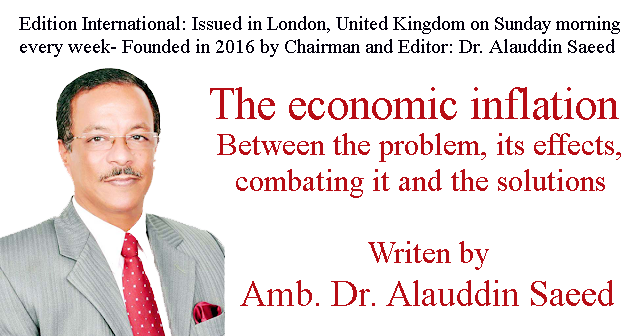Dr. Alauddin Saeed, writes: The economic inflation.. Between the problem, its effects, combating it and the solutions
ARAB GAZETTE - LONDON..
Introduction:
The inflation
is a key economic concern for both consumers and businesses. But what exactly
is inflation? And how do we measure it? In this article, we'll explore these
questions and more, including the effects of inflation and how it can be
combated.
How
to measure economic inflation ?!:
The
consumer price index:
The
consumer price index (CPI) is the most commonly used measure of inflation. It
is a weighted average of prices of a basket of goods and services purchased by
a typical urban consumer. The CPI basket includes items such as food, housing,
clothing, transportation, and medical care. The CPI is released monthly by the
Bureau of Labor Statistics.
The
producer price index:
The
producer price index (PPI) measures the average change in prices received by
producers for their output. The PPI covers a wide range of finished goods and
services including agricultural products, mining products, manufactured goods,
construction materials, and energy products. The PPI is released monthly by the
Bureau of Labor Statistics.
The
gross domestic product deflator:
The
gross domestic product deflator (GDP deflator) is a measure of inflation that
takes into account changes in both prices and quantities produced. It is
calculated as the ratio of nominal GDP to real GDP multiplied by 100. The GDP
deflator is released quarterly by the Bureau of Economic Analysis.
The
effects of inflation:
The
effect on consumers:
Inflation
has a number of effects on consumers. First, it reduces the purchasing power of
money, which means that each unit of currency buys fewer goods and services.
This is sometimes referred to as "currency devaluation." Second,
inflation may lead to higher interest rates, which can make borrowing more
expensive and reduce the amount of money available for consumption. Finally,
inflation can create uncertainty and cause people to save rather than spend,
which can lead to slower economic growth.
The
effect on producers:
Inflation
can also have an impact on producers. For example, if the cost of raw materials
and other inputs increases, this can eat into profits and make it difficult to
compete with foreign firms. Additionally, high inflation can lead to wage
increases, which can put pressure on prices and further erode profits. Finally,
like consumers, businesses may also be reluctant to invest in a climate of high
inflation due to the associated uncertainty.
The
effect on the government:
Inflation
can have both positive and negative effects on government finances. On the one
hand, rising prices may lead to higher tax revenues as people's incomes
increase (assuming that tax brackets are not adjusted for inflation). On the
other hand, high inflation can erode the value of government debt and make it
more difficult to finance government spending. In addition, governments may
need to take action to combat inflationary pressures, such as increasing
interest rates or implementing fiscal austerity measures, which can have
negative effects on economic growth.
How
to combat inflation?!:
Monetary
policy:
Monetary
policy is the process by which a country's central bank manages the money
supply in order to achieve specific economic objectives. The most common goal
of monetary policy is to stabilize prices and keep inflation low. Central banks
use two main tools to implement monetary policy: open market operations and reserve
requirements.
Open
market operations involve the buying and selling of government securities in
the open market in order to expand or contract the money supply. Reserve
requirements are the percentage of deposits that banks must hold in reserve and
not lend out. By changing reserve requirements, central banks can influence the
amount of loans that banks make, and therefore the money supply.
Fiscal
policy:
Fiscal
policy is the use of government spending and taxation to influence the economy.
Fiscal policy can be used to combat inflation by reducing government spending
or increasing taxes, which would reduce aggregate demand and slow down economic
growth.
Supply-side
policies:
Supply-side
policies are designed to increase productivity and encourage economic growth.
These policies include deregulation, tax cuts, and investment in infrastructure
and education. Supply-side policies can help combat inflation by increasing the
supply of goods and services, which would put downward pressure on prices.
Conclusion:
The
consumer price index, producer price index, and gross domestic product deflator
are all ways to measure economic inflation. The effects of inflation can be
felt by consumers, producers, and the government. In order to combat inflation,
policy makers can use monetary policy, fiscal policy, or supply-side policies.






